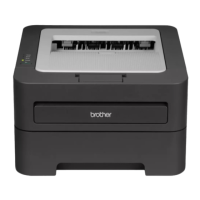Why is my Brother Printer leaving dirt on the paper?
- GGregory MasseySep 12, 2025
If your Brother printer is leaving dirt on the paper, the fuser unit might be dirty. Clean the entrance of the fuser unit, or clean the pressure roller.

Why is my Brother Printer leaving dirt on the paper?
If your Brother printer is leaving dirt on the paper, the fuser unit might be dirty. Clean the entrance of the fuser unit, or clean the pressure roller.
Why is my Brother HL-2230 feeding paper at an angle?
If your Brother printer is feeding paper at an angle, the main PCB might be faulty and require replacement.
Why is the paper curling when printed from my Brother HL-2230 Printer?
If the paper is curling after being printed by your Brother printer, the fuser unit might be failing and require replacement.
| Network ready | No |
|---|---|
| Print technology | Laser |
| Maximum resolution | 2400 x 600 DPI |
| Time to first page (black, normal) | 8.5 s |
| Print speed (black, normal quality, A4/US Letter) | 24 ppm |
| Printing colors | Black |
| Maximum duty cycle | - pages per month |
| Number of print cartridges | 1 |
| Sound power level (standby) | 31 dB |
| Sound pressure level (printing) | 53 dB |
| Total input capacity | 250 sheets |
| Total output capacity | - sheets |
| Custom media width | 76.2 - 220 mm |
| Maximum print size | 216 x 356 mm |
| Custom media length | 116 - 406.4 mm |
| Paper tray media types | Bond paper, Plain paper, Pre-Printed |
| Paper tray media weight | 60 - 105 g/m² |
| Non-ISO print media sizes | Executive (184 x 267mm), Folio (media size), Letter (media size), Legal (media size) |
| ISO A-series sizes (A0...A9) | A4, A5, A6 |
| ISO B-series sizes (B0...B9) | B5, B6 |
| Maximum ISO A-series paper size | A4 |
| Standard interfaces | USB 2.0 |
| Windows operating systems supported | Yes |
| AC input voltage | 120 V |
| AC input frequency | 50 - 60 Hz |
| Power consumption (off) | 0.9 W |
| Power consumption (printing) | 495 W |
| Power consumption (PowerSave) | 65 W |
| Package weight | 8000 g |
| Compatible operating systems | Windows 2000 Professional, XP Home Edition, XP Professional Edition, XP Professional x64 Edition, Server 2003, Server 2003 x64 Edition, Vista, Server 2008, Server 2008 R2, Windows 7 Mac OS X 10.4.11, 10.5.x, 10.6.x |
| Sustainability certificates | ENERGY STAR |
| Storage temperature (T-T) | 10 - 32.5 °C |
| Operating relative humidity (H-H) | 20 - 80 % |
| Bundled software | Interactive Help |
| Dimensions (WxDxH) | 368 x 360 x 183 mm |
|---|
Provides general specifications like print method, resolution, speed, warm-up time, CPU, memory, etc.
Details wired and wireless network capabilities for different models.
Information on printer life, MTBF, MTTR, and parts life.
Details toner cartridge and drum unit specifications and yield.
Covers paper handling and media specifications for various paper types.
Shows the non-printable margins for different paper sizes.
Introduces troubleshooting procedures and essential precautions for service personnel.
Provides cross-section drawings, paper feeding paths, and component descriptions.
Explains LED error codes at operator and service calls for fault diagnosis.
Lists common error symptoms with causes and remedies for troubleshooting.
Essential safety measures to follow before and during maintenance.
Illustrates the packing procedure and components for shipping or storage.
Lists and illustrates various screw types used in the printer assembly.
Specifies the correct tightening torque for different screws during assembly.
Details lubrication points and quantities for specific parts.
Shows diagrams and names of gears in the paper feeder and development parts.
Illustrates the routing paths for various wire harnesses within the printer.
Provides a flowchart showing the sequence of disassembly steps.
Step-by-step instructions for disassembling various printer components.
Procedures for rewriting firmware, setting paper size, and serial number after PCB replacement.
Instructions for inputting adjusted values after replacing the laser unit.
Procedure for resetting the irregular power supply detection counter.
Explains how to enter and use end-user and service maintenance modes.
Details how to print printer configuration and maintenance information.
Covers functions like reprint, job cancel, wireless settings, and drum cleaning.
States that there are no parts requiring periodic replacement.
FCC compliance statement for USA regarding radio frequency emissions.
Warnings and cautions related to laser product safety during servicing.
Important notes on handling the optical system and laser beam safety.
Explains how to read and interpret the printer's serial number label.
Instructions for creating protective material using old-style paper strips.
Instructions for creating protective material using new-style paper strips.